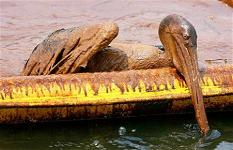A drilling rig explosion on April 20 left 11 workers missing and presumed dead, and the rig’s subsequent collapse unleashed a major oil spill that threatens the ecosystems and economy of the U.S. Gulf of Mexico.Also threatened is the heart of U.S. energy production, as a giant, unprecedented underwater leak spreads oil across the northern Gulf of Mexico, threatening areas from Florida to points west of the of the Mississippi River.
President Barack Obama’s plans to widen offshore drilling have been suspended, and energy giant BP Plc (BP.N) (BP.L) faces another blow to its reputation and a multibillion-dollar bill for cleaning up the mess and paying damages.
Below is a chronology of the spill and its impact:
* April 20, 2010 – Explosion and fire on Transocean Ltd’s (RIG.N) (RIGN.S) drilling rig Deepwater Horizon licensed to BP; 11 workers missing, 17 injured. The rig was drilling in BP’s Macondo project 42 miles (68 km) southeast of Venice, Louisiana, beneath about 5,000 feet (1,525 metres) of water and 13,000 feet (4 km) under the seabed. A blowout preventer, intended to prevent release of crude oil, failed to activate.
* April 22 – The Deepwater Horizon rig, valued at more than $560 million, sinks and a five-mile long oil slick is seen.
* April 23 – The U.S. Coast Guard suspends search for missing workers.
* April 25 – The Coast Guard says remote underwater cameras detect the well is leaking 1,000 barrels of crude oil per day. The agency calls the leak a “very serious spill” that threatens ecosystems along the Gulf Coast. It approves a plan to have remote underwater vehicles activate a blowout preventer and stop leak, but the effort fails.
* April 26 – BP’s shares fall 2 percent on fears the cost of cleanup and legal claims will deal the London-based energy giant a heavy financial blow.
* April 27 – U.S. departments of Interior and Homeland Security announce joint investigation. Coast Guard says leaking crude may be set ablaze to slow the spread of oil in the Gulf.
* April 28 – The Coast Guard says the flow of oil is 5,000 barrels per day (bpd) (210,000 gallons/795,000 litres) — five times greater than first estimated. A controlled burn is held on the giant oil slick.
* April 29 – Obama pledges “every single available resource,” including the U.S. military, to contain the spill, which Homeland Security Secretary Janet Napolitano says is of “national significance.” Obama also says BP is responsible for the cleanup. Louisiana declares state of emergency due to the threat to the state’s natural resources.
* April 30 – An Obama aide says no drilling will be allowed in new areas, as the president had recently proposed, until the cause of the Deepwater Horizon accident is known.
* BP Chairman Tony Hayward says the company takes full responsibility and will pay all legitimate claims and the cost of the cleanup. The Interior Department orders safety inspections of all 30 deepwater drilling rigs and 47 deepwater production platforms.
* May 1 – Coast Guard says leak will affect the Gulf shore.
* May 2 – Obama visits the Gulf Coast to see cleanup efforts first hand. U.S. officials close areas affected by the spill to fishing for an initial period of 10 days. BP starts to drill a relief well alongside the failed well, a process that could take two to three months to complete.
* May 5 – A barge begins towing a 98-ton containment chamber to the site of the leak. BP says one of the three leaks has been shut off by capping a valve, but that would not cut the amount of oil gushing out.
* May 6 – Oil washes ashore on the Chandeleur Islands off the Louisiana coast, uninhabited barrier islands that are part of the Breton National Wildlife Refuge and important nesting and breeding areas for many bird species.
* May 7 – BP engineers use undersea robots to move the containment chamber over the larger of the two remaining leaks on the seabed. A fishing ban for federal waters off the Gulf is modified, expanded and extended to May 17.
* May 8 – BP’s containment dome hits a snag when a buildup of crystallized gas forces engineers to postpone efforts to place the chamber over the oil leak and siphon oil to the surface. “Tar balls” suspected to come from the leak wash up along a half-mile stretch of Dauphin Island, Alabama.
* May 9 – BP says it might try to plug the undersea leak by pumping materials such as shredded up tires and golf balls into the well at high pressure, a method called a “junk shot.”
* May 10 – Forecasts suggest the oil spill could move significantly west of the Mississippi River delta as brisk onshore winds prevail. BP announces plans to place a small containment dome, known as a “top hat,” over the blown out well to funnel oil to the surface.
* May 11 – Executives with BP, Transocean and Halliburton appear at congressional hearings in Washington, where Senators criticize their safety records. The executives blame each other’s companies for the explosion. The oil slick washes ashore on a third land mass: Louisiana’s Port Eads area, on the southern edge of the Mississippi Delta.(Reuters)

